 |
Climbing and Gymnastics A Historical Association |
 |
Climbing and Gymnastics A Historical Association |
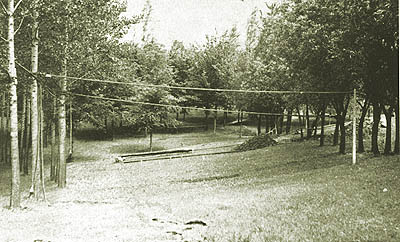 Ropes, both horizontal and vertical. The military still uses ropes for training. |
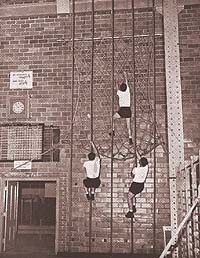 Naval Aviation cadets climbing ropes and a wall or cargo net. (early 1940s) |
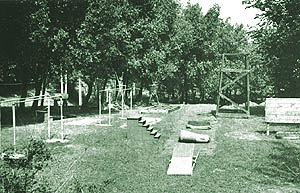 on the right, probably used for (parachute landings) training |
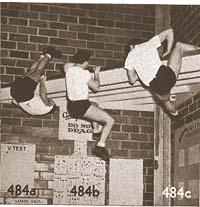 Naval air cadets, during the early 1940s, on a climbing shelf |
Transition . . .
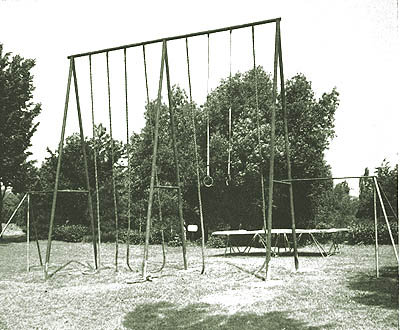 The
illustrations of early gymnastics show clearly that originally there
were climbing components
- poles,
ladders,
ropes
and the
like. Indeed, above and to the right are photos of outdoor gymnasiums
from later - the 1930s and 1940s - showing climbing ropes.
By this time oblique
ladders had virtually vanished from both indoor
and outdoor gyms, replaced in some instances with vertical
ladders - Swedish stall bars, e.g. - and with horizontal ladders,
which still exist in special settings. Particularly in military,
police, (and terrorists) training sites. The
illustrations of early gymnastics show clearly that originally there
were climbing components
- poles,
ladders,
ropes
and the
like. Indeed, above and to the right are photos of outdoor gymnasiums
from later - the 1930s and 1940s - showing climbing ropes.
By this time oblique
ladders had virtually vanished from both indoor
and outdoor gyms, replaced in some instances with vertical
ladders - Swedish stall bars, e.g. - and with horizontal ladders,
which still exist in special settings. Particularly in military,
police, (and terrorists) training sites.At one time gymnasiums were festooned with climbing ropes, challenging youngsters to exert themselves and take responsibility for their own safety. Nowadays, liability considerations and a general movement away from old fashioned, demanding equipment has made them a rarity. The final formal competitive rope climbing events - judged on speed of ascent - occurred in the early 1960s, as we shall see below. For a time, rope , peg-boards, etc. remained for casual or instructional purposes. But these have largely given way to artificial climbing walls - in the 1970s in Europe, and the 1990s in America. Strenuous but safe, with muscular demands diminished and shifted from the arms to the hands and fingers, climbing walls are accessible to almost anyone - male or female - in reasonable physical shape. Go to the nearest climbing gym and see for yourself : little children scampering up rock facades, their thin and undeveloped arms no hindrance to progress. In an age of instant gratification, climbing walls are just the ticket - but many of those sailing from handhold to handhold would have trouble making it up and down a 25 foot climbing rope entirely on their own. Of course, climbing walls offer a large number of permutated problems - far greater intellectual challenges - compared to the stark simplicity of a rope. But the rope requires both strength and self-reliance - especially when climbing with the hands only. |
Rock
Climbing vs. Rope
Climbing : Which is the Most Appropriate for Athletic Competition?
After years of rock climbing and rope climbing, my assessment of these activities as competitive venues is as follows : As an adventurous lifestyle, rock climbing is, of course, far ahead of rope climbing. But, as an athletic competition, rope climbing is far superior to rock climbing and bouldering. Physical differences - height, reach, compactness, thinness, finger size, bodily limb ratios, etc. - can substantially affect the perceived difficulty of a rock climbing move, but these differences are for the most part relatively inconsequential for rope climbing, in which practice tends to be by far the most important aspect of successful participation. Tall rope climbers generally move their limbs a bit slower than short climbers, but they reach further, equalizing the challenge of the sport. Hand and finger size are usually immaterial. It all comes down to strength and power and speed. So, if you are a youngster who climbs 5.12 after only a few months on the rock, I challenge you to test yourself on the rope - hands only! |
A few personal comments Jack Keen - A Role Model . . . I remember two of the rope climbers at Tech when I was there: The late "Bo" Stokes and Jack Keen. Jack, one year my senior, was a pole vaulter as well as a gymnast. When he wasn't pole vaulting or throwing the javelin, he would wander into the gym, pull a perfect front lever on the horizontal bar, and fly up the 20 foot rope several times. Although I don't recall him being faster than Bo, his style was extremely impressive due to his incredible strength. Back outside, he would frequently walk a barrel upon which he was doing a handstand down the length of the football field. I heard that Jack took the Army Fitness Test and set a new record. On campus, his name inspired a certain awe, if not outright hero-worship! He got a degree in Industrial Management, then became a high school coach, founded the Atlanta Track Club, and upon retirement in 2003 was named to the Georgia Athletic Coaches Association Hall of Fame. He was also a mathematics teacher and was named Star Teacher of the Year 27 times at Jefferson High, near Athens. Personal Observations . . . I got started climbing rope and working the still and flying rings after I had finished the required gymnastics course at Georgia Tech, and began occasional practices with several members of the Tech Gymnastics Squad. Lyle Welser, the coach, encouraged me to do this. I didn't really feel competent, however, until I was well into my sophomore year. At the end of that year I transferred to the University of Georgia , which had a better pure mathematics program, but no gymnastics team - even though the appartus was available. At UGA I got a very small group of "stranded" male gymnasts together as an informal club and we met several times a week to work out during 1956 - 1958. My fastest recorded time on the 20' rope - hands only from a seated position on the floor - 3.4 seconds - was at the University of Georgia in 1958. My father - a professor at the University - held one of the stopwatches. Not very close to the record of 2.8 seconds. The next year I climbed rope, worked out on the still rings, and helped out a little with Coach Bob Kreidler's University of Chicago team as I studied meteorology for the USAF. I never recorded a better time on the rope, so I probably never broke the 3 second barrier. By 1967 I had stopped doing the climb. Competitive-style rope climbing was terrific preparation for dynamic climbing, and was a major influence on my perspective of rock climbing. It would be a wonderful divertissement, an activity for modern rock climbers to resurrect, although pressures within the climbing community make that possibility unlikely. It now takes most if not all of top rock climbers' energies to remain competitive in their sport. Rope climbing would not be a profitable use of their time. However, for others, it would provide an interesting challenge. Don Perry was a very normal looking person as I recall, without Smith's powerful muscles. This infers that perhaps women could excel in this forgotten sport . . . To the best of my knowledge there has never been a competitive-style female rope climber, although female circus performers regularly climb ropes or poles. Furthermore, I believe the "world record" - established in Philadelphia in 1918 - for consecutive one-arm pull-ups (27) is still held by a German female circus performer from that era: Lillian Leitzel (1892-1931). Her circus routine was done on a single suspended ring or rope, from which she did various swinging stunts hanging from one arm. She was 4'9" tall and weighed 95 pounds. It appears she did her one-armers by flipping her body, the technique she used in her circus performances. |